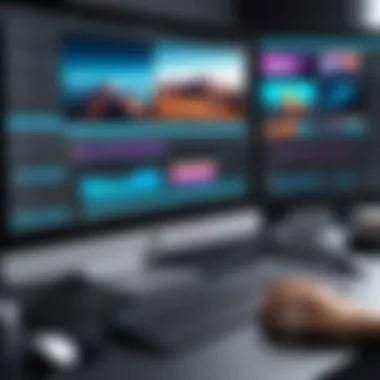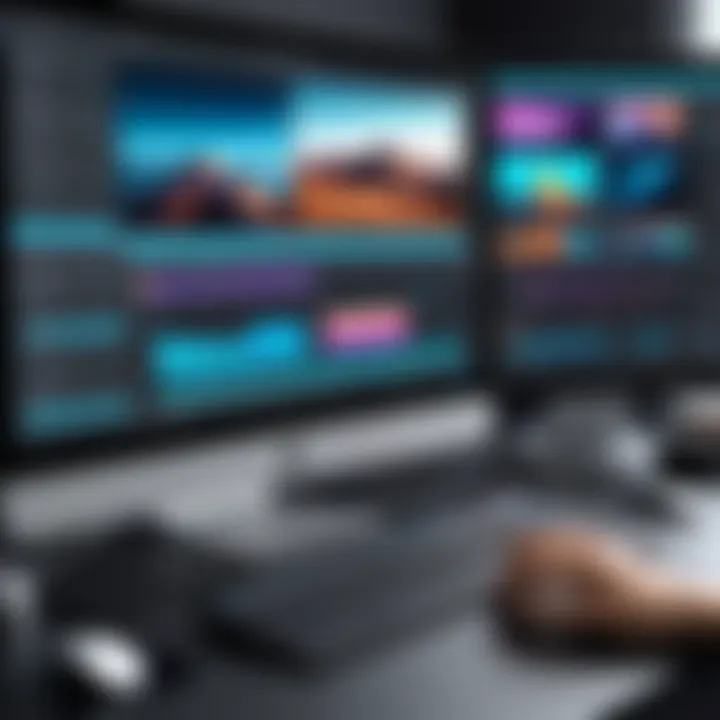Aesthetic Video Maker: Tools, Techniques, and Trends


Intro
In an era where visual storytelling reigns supreme, understanding the ins and outs of aesthetic video creation is paramount. From social media snippets to full-length cinematic experiences, the demand for visually engaging content has taken off. As such, creators now face the challenge of marrying technical skill with artistic flair. This article takes a closer look at the world of aesthetic video makers, shedding light on the tools, techniques, and emerging trends that shape this dynamic field.
Whether you're a budding filmmaker or a tech enthusiast yearning to master the art of video creation, knowledge of the latest technology is essential. Here, we’ll navigate through the capabilities and unique features of aesthetic video makers, discuss their design and usability, and delve into the innovative techniques that elevate video quality.
Prelude to Aesthetic Video Making
In a world where visuals reign supreme, understanding aesthetic video making becomes increasingly relevant. This practice transcends merely compiling footage; it’s about weaving a narrative thread through compelling visuals that resonate and engage. The importance here lies not just in the outcome but also in the process—combining technology, creativity, and artistic expression.
Aesthetic video making serves as a medium through which creators can articulate ideas and evoke emotions. It’s about crafting an experience, one that can captivate audiences and significantly influence their perception of stories being told. The benefits are multifaceted: not only can someone sharpen their storytelling skills, but they also gain insight into various tools and techniques that can vastly improve their craft.
When you delve into aesthetic video making, you start to consider various elements that play a pivotal role in shaping the visual experience. From color palettes to composition, and lighting choices to sound design, each component can enhance the narrative flow and emotional impact. Creators must consider how these elements interact to cultivate a specific mood or feel.
The exploration of aesthetic video making encourages tech-savvy individuals to embrace new trends and tools. This field is hardly static; it evolves continuously, reflecting advancements in technology and shifts in artistic preference. As a result, understanding the historical context and the various methods employed throughout different time periods enriches the creative perspective of anyone venturing into this art form.
By not just understanding but engaging with varied techniques and tools, creators can elevate their projects and, in turn, the audience's experience.
Thus, this article seeks to provide a comprehensive understanding of aesthetic video making, highlighting not only its essential tools and techniques but also the trends shaping its future. It aims to empower budding creators with the knowledge and inspiration to craft their own compelling visual narratives.
Essential Tools for Aesthetic Video Makers
When it comes to creating visually striking videos, having the right tools is half the battle. Aesthetic video making isn’t just about a great concept; it also hinges on the technology that supports that vision. This section will delve into essential tools that every video maker should consider, breaking down software and hardware to enhance creativity and expression.
Software Choices: From Basics to Advanced
Overview of Popular Software
Software is central to the editing process. Tools like Adobe Premiere Pro, Final Cut Pro, and DaVinci Resolve have carved out a reputation amongst creators. Each of these tools harbors unique capabilities, catering to various experience levels. For instance, DaVinci Resolve, initially admired for its color correction prowess, has expanded to offer a comprehensive editing suite with an approachable free version. This makes it a solid choice for those just dipping their toes into video editing.
- Key Characteristics:
- Intuitive interface
- Robust support community
The relative ease of access to tutorials sets it apart, ensuring a smoother learning curve for novices. However, as you delve deeper into its advanced features, you might encounter a steeper learning curve that could discourage some.
Key Features to Consider
Choosing the right editing software isn’t a one-size-fits-all scenario. Assessing factors like usability, processing power, and the specific functionalities you need can significantly heighten your editing experience. For instance, Adobe Premiere Pro is favored by many for its versatility with plugins and integration with other Adobe products, making it a strong player for professionals.
- Key Characteristics:
- Extensive features, including motion graphics and audio editing
- Regular updates with new tools and features
However, an extensive feature set can be overwhelming for beginners who might not utilize most of these capabilities initially. Finding a balance between complexity and necessity is crucial.
Free vs Paid Options
The cost of software can vary widely. Free options, like Shotcut and Lightworks, can serve as excellent starting points without financial risk. They provide foundational tools for basic editing. Meanwhile, paid options often come jam-packed with features that might be necessary for professional work.
- Key Characteristics:
- Free software may lack some advanced features
- Paid software usually provides a more streamlined workflow and customer support
Choosing between free and paid isn’t just about your budget but understanding your goals and how serious you are about video making.
Hardware Recommendations
Going beyond software, the hardware foundation is equally important to creating high-quality videos. You won't get far with great software and a shaky camera.
Cameras and Lenses
High-quality imagery begins with the right camera. Options range from DSLRs like Canon EOS R to mirrorless cameras like Sony A7C, each offering varying benefits such as portability and image quality. The choice of lenses can also dramatically affect the final look of your videos. A good 50mm lens can create a lovely bokeh effect, while a zoom lens can provide versatility in shooting.
- Key Characteristics:
- Varied lens choices can enhance creative options
- Different formats provide various shooting capabilities
Despite offering breathtaking visuals, high-end cameras can come with a price tag that's hard to swallow for those on a tight budget. It's essential to weigh the benefits of investment against your specific needs.
Stabilization Equipment


Having steady shots elevates the visual quality immensely. Gimbals and steadicams can help maintain smooth, fluid motion while shooting. Stabilization equipment serves not just aesthetic purposes but can also enhance storytelling by providing a seamless viewer experience.
- Key Characteristics:
- Helps create professional-looking footage
- Portable options available for easy transport
While these devices can be seen as an extra expense, they can vastly improve the production value of your videos, making it an investment worth considering.
Audio Devices
Sound quality often plays second fiddle, yet can make or break your video. Good microphones, such as the Rode VideoMic Pro or Audio-Technica AT2020, can capture clear audio while minimizing background noise. Not to mention, investing in audio gear helps in making your storytelling vivid and engaging.
- Key Characteristics:
- Improves overall production value
- Specialized options exist for various filming environments
While audio devices often require a bit more setup, the clarity and richness they bring to the viewer’s experience make them worthwhile additions to your toolkit.
"An aesthetic video isn’t solely about visuals; it’s the fusion of image, sound, and motion that crafts a compelling narrative."
By integrating the right software and hardware tools, video creators can truly unleash their imagination. The marriage of technology and artistry allows creators to tell stories that resonate, capturing and holding the interest of their audience.
Key Techniques for Crafting Aesthetic Videos
Crafting aesthetic videos is not just about throwing together flashy visuals; it's an intricate blend of various elements that enhance the overall viewing experience. Each technique plays a crucial role in shaping narratives and evoking emotions. When done right, these techniques can transform ordinary footage into something that resonates deeply with viewers. Below are some foundational techniques that can elevate the aesthetic quality of your videos.
Understanding Composition
Rule of Thirds
The Rule of Thirds is a basic principle that guides video makers in framing their shots. It involves dividing the frame into a grid of nine equal segments by two vertical and two horizontal lines. The idea is to place the most important elements of your scene along these lines or at their intersections. This approach leads to a more balanced and visually appealing composition. Its popularity stems from its simplicity and effectiveness. By adhering to this principle, creators can draw the viewer's eye to key subjects without the clutter of a centralized composition.
However, while the Rule of Thirds is a fantastic guideline, strict adherence can sometimes make videos feel formulaic. Using it as a starting point and then experimenting beyond can yield unique and striking results.
Framing and Perspectives
Framing and perspectives are about how subjects are placed within the scene, which directly impacts how a story is conveyed. Choosing different angles and frames can radically alter the perception of the viewer. For instance, a low angle might make a subject seem powerful, while a high angle can evoke feelings of vulnerability. This technique allows for creativity in storytelling and can significantly enhance the aesthetic value of the video.
Utilizing various framing techniques helps to guide the audience’s focus and adds layers to the narrative. The challenge lies in balancing the aesthetic appeal while ensuring clarity and meaning in the scene, which is essential for effective storytelling.
Color Theory and Its Application
Color can significantly influence the mood and tone of a video. Making intentional choices about color can evoke emotions, signal transitions, and define character traits, all of which contribute to the overall aesthetics.
Creating Mood with Color
Creating mood with color is all about using hues and shades to craft an emotional backdrop for the story being told. Different colors evoke different feelings: warm tones can impart warmth and comfort, while cooler tones often convey sadness or isolation. Being conscious of color palettes can help achieve a desired mood and setting. This technique beckons the viewers to engage more profoundly with the content.
However, oversaturation or inappropriate color choices might detract from the intended mood, which can confuse viewers. Hence, striking the right balance is paramount to harnessing color effectively.
Color Grading Techniques
Color grading is the process of altering and enhancing the color of a video. This technique plays a significant role in unifying a video visually and emotionally. By applying various color grading styles, one can create a distinct aesthetic for the entire project, making it instantly recognizable.
Tools like Adobe Premiere Pro or DaVinci Resolve allow for sophisticated color grading options. While it requires some technical know-how, the distinct look that comes from well-executed color grading is worth the effort. However, overdoing grading can lead to unnatural looks, pulling viewers out of the experience.
The Role of Lighting
Lighting is often said to be the unsung hero of video making. Properly harnessing light can create depth, highlight key features, and evoke the right sensations. It's about using light not just as a functional tool but as a creative element.
Natural vs Artificial Light
Natural light has a certain dynamic quality that can add warmth and authenticity to a video. It shifts and changes, creating unique moods based on time of day and weather. However, using it effectively can be tricky, as it often requires careful planning and sometimes waiting for the right moment.
In contrast, artificial light offers control that is invaluable in video making. Various light sources, like softboxes and LED panels, allow for precise shaping of shadows and highlights. Nevertheless, artificial lighting might sometimes lead to a more staged look, which can feel less organic than natural light.
Techniques for Effective Lighting Control
Exploring lighting techniques is essential for anyone looking to enhance their aesthetic video making. Techniques such as three-point lighting can help illuminate subjects in a balanced manner, ensuring that shadows complement instead of detract from the scene. It combines key, fill, and backlighting for a polished look.
While controlling lighting can vastly improve the aesthetic quality of a video, the key is to maintain clarity and avoid overly harsh shadows or bright spots that may distract the viewer or obscure details.


Editing Styles that Enhance Aesthetics
Editing is where the magic happens, turning raw footage into a cohesive narrative with aesthetic appeal. This stage can significantly shape the viewer's experience and perception of the video.
Cutting and Transition Techniques
Cutting involves selecting the best shots to weave a story together seamlessly, while transitions help to create flow between those shots. Techniques like jump cuts can provoke feelings of urgency or excitement, while fades and dissolves can convey a more contemplative mood. Mastery of these techniques enhances engagement by reinforcing the narrative pace and rhythm.
Nevertheless, overusing specific cuts or transitions can lead to disjointed storytelling, which might leave viewers confused rather than engaged.
Sound Design and Its Importance
Sound design is a crucial yet often overlooked aspect of video making. The right audio can set a tone, elevate tension, and create an immersive experience. Background scores, sound effects, and dialogue all contribute to the overall success of the aesthetic. The quality of sound directly impacts the viewer's emotional response. A well-crafted sound design intertwines so well with visuals that it’s felt rather than just heard.
However, poor sound choices can overshadow the visual narrative and distract the audience from the core message. Thus, giving sound its due attention during post-production is vital for a truly cohesive final piece.
"In video making, the harmony between visuals and sound is crucial, much like a dancer who must synchronize their movements to the rhythm of music."
The techniques discussed are a tapestry of creativity that intertwines to form breathtaking aesthetic experiences. Focusing on these aspects not only strengthens the video’s impact but ensures it resonates with its intended audience, maximizing both artistry and storytelling.
Exploring Aesthetic Influences
Understanding the influences that shape aesthetic video making is crucial. It lays the groundwork for how creators approach their projects, influencing both content choices and technical decisions. Aesthetic influences can come from various sources—culture, art history, fashion, and even technology itself—resulting in a rich tapestry of visual storytelling. This exploration not only highlights the significance of aesthetics but also prepares creators to adapt to the ever-evolving landscape of video production.
Cultural Impact on Aesthetic Choices
Cultural contexts play a monumental role in determining aesthetic choices. Different societies have unique visual languages that reflect their values, beliefs, and experiences. For instance, in Scandinavian design, minimalism reigns supreme, with a focus on functionality and simplicity. This is often mirrored in video projects from these regions, which lean towards clean lines and effective narratives devoid of excessive embellishments. On the flip side, cultures steeped in vibrant histories, such as those in South Asia, may employ bold colors and intricate details, adding textural depth to their videos.
Incorporating these cultural aesthetics enhances the narrative, making it relatable to specific audiences while also extending an invitation for global viewers to appreciate diverse perspectives. Hence, creators must be aware of these influences to craft stories that resonate deeply.
Current Trends in Aesthetic Video Making
The aesthetic scene is never stagnant; it continually adapts to reflect current societal trends, technological innovations, and artistic movements. Two of the notable current trends are Minimalist Styles and Vibrant and Dynamic Editing, each possessing distinct characteristics and appealing to various creators and audiences alike.
Minimalist Styles
Minimalist styles focus on simplicity and clarity, stripping away the unnecessary to highlight the essence of a narrative. This method emphasizes the "less is more" philosophy, where every frame counts, and each visual choice delivers maximum impact. A key characteristic is the use of negative space, which allows the viewer's eye to rest and fosters a sense of calm.
The advantage of minimalist styles is their ability to convey profound messages without overwhelming the audience. Videos bearing this aesthetic often become timeless, as they resist trends tied to specific eras. However, while minimalism shines in elegance, it can occasionally risk appearing too sparse or detached for viewers seeking intricate details or lively interactions.
Vibrant and Dynamic Editing
Contrast is vibrant and dynamic editing, a trend that thrives on energy and engagement. This style employs quick cuts, bold colors, and intricate transitions to create a sense of motion and excitement, making it particularly appealing for action-driven narratives or promotional content.
These videos generally maintain viewer attention by blending visuals with strong sound design, effectively gripping the audience from the get-go. One unique feature of this approach is its flexibility, adapting easily to various genres, from music videos to advertisements. However, the fast pace may also make it challenging for viewers to fully digest the underlying story or message, leading to potential disengagement if done excessively.
Embracing either minimalist or dynamic styles provides video makers with tools to craft stories that not only entertain but also resonate, anchoring their work in the broader cultural conversation.
In summary, aesthetic influences, notably through the lenses of cultural impact and current trends, are foundational elements in aesthetic video making. By navigating these influences wisely, creators can bridge the gap between technology and artistry, ultimately elevating their storytelling capabilities to remarkable heights.
The Future of Aesthetic Video Making
The direction in which aesthetic video making is headed holds profound implications for creators, businesses, and the audience alike. As technology evolves, so too does the landscape of video creation. The importance of understanding this future cannot be overstated; it represents not just a continuation of existing practices but a leap into new realms of creativity and expression. Video makers need to adapt and stay ahead, ready to embrace what lies ahead.
Technological Innovations on the Horizon
The surge of technological advancements is what can set one video creator apart from the rest. Some innovations to keep an eye on include:
- AI-Assisted Editing: Tools like Adobe Premiere Pro are integrating machine learning to suggest edits, making the editing process faster and more intuitive. Imagine software that learns your style and makes suggestions based on your past work.
- Virtual Reality (VR) and Augmented Reality (AR): These technologies will allow creators to craft immersive experiences. Just think of how travel vlogs could be enhanced with viewers navigating new locations through VR headsets.
- 360-Degree Cameras: The advent of cameras that capture a complete sphere of view lets viewers feel part of the action. The ability to interact with the video environment will draw audiences in ways conventional video cannot.
A future where videos are not just watched but experienced is closer than we think.
These tools will not only improve the technical quality of videos but also broaden the narrative opportunities for creators.
Anticipated Trends and Shifts
As we leap into the future, various trends are likely to shape the aesthetics of video making. These shifts can redefine how stories are told. Pay attention to:
- Short-Form Content: Platforms like TikTok are popularizing 15-60 second videos. Expect creators to focus on impactful storytelling with fewer resources and time. Content that grabs attention within seconds will become the norm.
- Integration of Interactive Elements: Future videos may include embedded surveys or clickable story choices, giving viewers a role in the narrative. This trend could radically change how stories are told by making the audience an active participant.
- Sustainable Practices: The push towards greener filmmaking will influence how aesthetic content is created. From eco-friendly materials to shooting in sustainable locations, creators are likely to adopt and promote environmentally conscious practices.
Changes in aesthetic video making will ultimately reflect the evolving values and tastes of society. Understanding these trends can provide aspiring creators a leg up in a rapidly shifting environment, making their content both relevant and impactful.


Practical Applications of Aesthetic Videos
The significance of aesthetic videos extends far beyond mere entertainment. They serve numerous practical applications that intertwine the realms of creativity and technology. Understanding these applications is crucial for creators and marketers alike as they navigate the evolving landscape of digital content. Aesthetic videos can be seen as a bridge between storytelling and visual engagement, which is vital for connecting with audiences on a deeper level.
Personal Projects and Expressions
Creating aesthetic videos for personal expression is a journey of self-discovery that encourages individuals to communicate their feelings and ideas through a visually captivating medium. Whether it involves capturing life's moments, expressing artistic inclinations, or telling unique stories, aesthetic videos allow a level of personal insight that resonates emotionally with viewers.
In this process, users often utilize varied skills and techniques acquired through practice. They play with colors, experiment with innovative editing styles, and curate chosen music to enhance emotional depth. This personal involvement can boost one's confidence and hone their creative skills as they explore their unique perspectives and amplify their voice.
- Showcasing Life Events: From graduation videos to travel adventures, giving life to experiences through aesthetic video-making offers a new lens to reminisce about cherished memories.
- Artistic Exploration: Many creators use this platform to experiment with artistic styles, pushing boundaries in visual storytelling, giving rise to new techniques that can influence broader trends.
Commercial and Marketing Uses
Aesthetic videos play an equally critical role in commercial and marketing arenas. With businesses striving for greater engagement across digital platforms, these videos serve as a potent tool for enhancing brand visibility. By incorporating aesthetic elements, brands can resonate more deeply with their target audience while effectively conveying their messages.
Brand Storytelling
Brand storytelling is a compelling aspect of marketing that utilizes aesthetic videos to foster connections with audiences. It’s about weaving a narrative around the brand itself, allowing for a more human touch in advertising. The key characteristic of brand storytelling lies in its ability to evoke emotions; when crafted effectively, it encourages viewers to engage with the brand on a personal level.
One unique feature of brand storytelling is its use of relatable characters and scenarios, which often portray challenges and triumphs in a way that audiences can see themselves. This can lead to higher viewer retention and loyalty, ultimately reflecting in sales and customer engagement rates. However, crafting such a narrative requires careful planning and creativity to ensure authenticity and avoid falling into overused marketing tactics that might appear disingenuous.
Social Media Presence
In the digital age, a strong social media presence is paramount, and aesthetic videos are’s central to achieving this. These videos are aesthetically pleasing and optimized for platforms such as Instagram, TikTok, and Facebook. They often capitalize on trends to capture user attention, making them a beneficial choice for businesses aiming to increase their reach.
- Visual Identity: Businesses using aesthetic videos can build a distinct visual identity, enabling them to stand out in a crowded market.
- Engagement Rates: Aesthetic visuals are known to boost engagement rates significantly, leading to more shares, likes, and positive comments, which can translate into brand awareness.
However, over-reliance on aesthetic appeal could sometimes overshadow the content's substance, necessitating a balance between beauty and clarity of message. Strategically integrating aesthetic videos into marketing campaigns opens up avenues for improved interaction and brand loyalty, marking them as a valuable asset for modern businesses.
Resources for Aspiring Aesthetic Video Makers
In the world of aesthetic video making, resources play a crucial role in shaping the abilities and techniques of emerging creators. The right tools and knowledge not only enhance creativity but also empower individuals to harness their artistic vision and translate it into captivating video content. By tapping into various resources, aspiring video makers can refine their skills, keep up with current trends, and effectively express their unique storytelling approaches.
Online Tutorials and Courses
The internet is a treasure trove for aspiring video makers looking to learn more about their craft. Numerous platforms offer online tutorials and comprehensive courses designed to cater to various skill levels, from novice to advanced users. Websites such as Udemy or Skillshare specialize in courses focused on aesthetic video production.
Enrolling in these courses provides several advantages:
- Structured learning paths with organized content.
- Access to instructors who can answer questions and provide feedback.
- A community of fellow learners for collaborative projects and discussions.
Moreover, platforms like YouTube host countless free tutorials that cover everything from basic editing principles to advanced color grading techniques. This flexibility allows aspiring makers to learn at their own pace, tailoring their education to their specific interests.
Communities and Networking Opportunities
Engaging with a community of like-minded individuals can be a game-changer for aspiring video makers. Connecting with others not only stimulates creativity but also leads to valuable learning opportunities. Within the realm of aesthetic video making, two main avenues for building connections are forums and online groups, and local meetups and workshops.
Forums and Online Groups
Forums such as Reddit, particularly subreddits focused on video editing and filmmaking, foster discussions that can spark inspiration and solve technical issues. These platforms allow users to share their work, seek critique, and gain insights into the latest trends. A key characteristic of forums is their accessibility; anyone can join and contribute, creating a vibrant tapestry of shared knowledge.
What makes forums a popular choice is their diverse user base — from seasoned professionals to enthusiastic newcomers. This diversity leads to a rich exchange of ideas that can benefit all members. For instance, a beginner may pose a question about editing software, while an experienced user might provide a nuanced response grounded in years of experience.
However, it's essential to be cautious of misleading or incorrect information that can sometimes surface in these environments. Thus, discerning which advice to follow can take some experience. Overall, forums are invaluable hubs for learning and networking.
Local Meetups and Workshops
On the other side of the spectrum, local meetups and workshops serve as a face-to-face means to develop skills and resources. These gatherings often involve hands-on learning experiences, live demonstrations, and opportunities to share work within a supportive environment. A key characteristic of these sessions is the community aspect, where individuals can form friendships and professional connections.
One unique feature of local meetups is the chance for direct interaction with industry professionals. This can provide invaluable insights into best practices that one might not access through online courses. Additionally, workshops may focus on specific skills, such as cinematography or post-production techniques, making them highly relevant for those looking to enhance specific areas of their craft.
Though the primary advantage of local workshops is the practical, hands-on experience, attendees must contend with the potential inconvenience of scheduling and travel. Yet, for many, the benefits of in-person learning outweigh these challenges.
Culmination
As we step back and gaze at the landscape of aesthetic video making, it's clear that the realms of technology and artistry are not merely side companions but rather dance partners in an intricate ballet. The sheer importance of recognizing their intersection cannot be overstated, particularly for those who venture to tell stories through a visual lens. Aesthetic video making is more than just throwing together pretty visuals; it’s about creating immersing experiences that resonate with audiences on multiple levels.
One of the major elements this article highlights is how technology provides the tools to push creative boundaries. The transition from basic to advanced software, for instance, empowers creators to manipulate footage in ways previously thought unattainable. This tech-savvy approach to aesthetics enables creators to sculpt their narratives, blending colors and styles for emotional impact.
Consider the rise of powerful editing software like Adobe Premiere Pro or Final Cut Pro. These platforms offer an arsenal of options for color grading and audio enhancement which, when used effectively, can transform a mundane video into an atmospheric masterpiece. With technology, you can now create moods and tell tales that linger long after the end credits roll.
However, it isn't just about the gadgets. The essence of aesthetic video making also lies in cultural influences and personal expressions. Today, minimalistic styles might captivate, while tomorrow’s trends could veer towards vibrant, dynamic editing. Keeping a pulse on these shifting trends is crucial. As creators, understanding and adapting to these movements not only enhances personal artistry but also ties their work to the broader societal context.
Another significant advantage is the practical application of aesthetic videos in various spheres—from personal projects, like capturing a travel journey, to commercial avenues that seek brand storytelling and strong social media presence. It’s intriguing how an aesthetic video can elevate a simple product showcase into a narrative-driven experience, engaging viewers by tugging at their emotions.
In essence, aesthetic video making challenges us to explore deeper and think beyond the typical frameworks. As the lines blur between technology and artistry, the potential for innovative storytelling grows exponentially. Ultimately, embracing this intersection not only fosters personal and professional growth but also enriches our cultural tapestry. Let’s look forward to seeing how aspiring creators will shape the future of visuals, armed with knowledge, tools, and a unique perspective.







